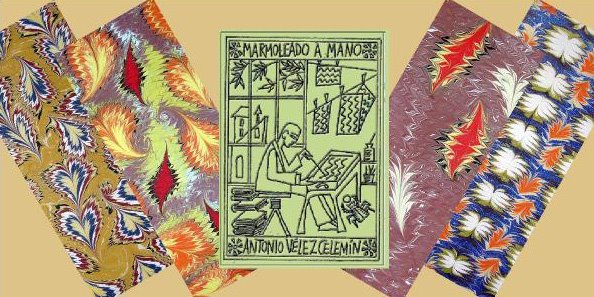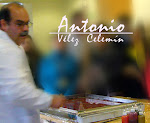*********
One of the things of marbling I like more is to teach it, and I do everything what I can for having opportunities to spread it. During hundreds of years his knowledge has been maintained secretly so that the privileged people that were on its possession could exploit exclusively its economic benefits. This could be understood while it was a trade union economy, as it was the European one when marbling was known for the first time towards the ends of the XVI th century.
But: now?
Now it does not make sense to continue with the secrecy. The one who devotes himself to it with exclusivity does not have to be afraid, what it has is a gift, and neither it is on the market, nor is possible to lose it.
Marbling will always have a place between the nostalgic professionals of the original product and the fans who love it with tenderness.
And it will have another place between the artists who want to use it like his expression medium.
The more the skill leaks out the more we will have more possibilities of being surprised and enjoyed by the imagination and the creativity of everybody.
As many more people dominate marbling, better it will be... for marbling.
I know that we not all think equally. Never mind.
An egoist keeps the beauty of his wife at home, he puts a veil on her face and it withers her in loneliness. Others show her in public, they are proud of her and of her beauty that is gaining ripeness without withering.
Do you understand it, isn’t?
On 2006 the Madrid local TV published a video, we spent the whole morning amusing ourselves recording it, then the journalists mounted it in a little bit and it was shown in the evening. The whole reportage in only four minutes, what big professionals ¡
You are invited to my workshop. In spanish, I'm sorry.
***
Some influences
Being truly "original" is a special talent of only a few. Others, like myself, can start with an original design and by adding our own work and ideas into it making a satisfying new creation: using my own new translations but still retaining some of the original .
Christopher Weimann (1946-1988) was a brilliant craftsman/artist working in the United States at a time when very little information about marbling was available. By trial and error he developed his special techniques that opened the way for many others to develop their own marbling skills. One of his favorite patterns was a repetitive series of precise drops that he would "comb" into patterns somewhat like a "kilim" or Turkish carpet design. Similar to this:

This paper is my interpretation. I transformed the drops into something like the butterflies in my collection. I have a great affection for all animals.


Working with the symmetrical drops and turning them into myriad designs is a natural evolving process for me. I have named some of these marbled papers:
"Seagulls"

“Broken hearts”

“Red intruders”

“Swirls“

And “Paramecium and protozoan”

The topic of hearts could be developed more and thinking in the many good persons there are in the world I filled them with gold.
"Golden Hearts"

Sumigashi, possibly the oldest original source of marbling, is said to have been a gift from the Japanese god, Kasuga, to Jiyemon Hiroba on February first in 1151. I marbled this paper with the "heart" theme.
"Hiroba heart"

Another marbling icon is the amazing ninety year old Norma Rubovits. She's retired now, but her head is plenty of youthful enthusiasm! One of her original series of designs is called "Vignettes". She places only a few drops of pigment allowing them to spread as if they were going to cover all of the space and then pushes them back. Here is an original example of her work. It is a delicate wonder to behold.

My work is much bolder and not as refined as Norma's, and it presents a different energy. Here is another "Butterfly" that I have done.

The stretched skin

All of the papers from my first post (H2O) have been done using these techniques. My current work has become much more elaborate than my earlier works.
In Orient since old times marbled papers were used as a base design for works of calligraphy. Oriental alphabets have tremendous artistic possibilities that gifted calligraphers developed constantly and the beautiful marbled designs enhance many scripts. Some of these calligraphers were also early marblers.
Here is my work. It is the first verse of the Koran in the shape of a stork. It is a figurative calligraphy done on a double marbled design.
A Bismillah.

Here is another. The name of Allah is repeated eight times in the shape of a star. This is done in the cufic calligraphic style of Emin Barin, a renownd, modern Turkish artist. The paper has been double marbled and stencils used to block out some of the design.

Double marbling seemed rather a new technique, but it's been used since marbling began. A german marbler, Franz Weisse created many double marbles in the 1930's. He likened some of his less successful papers to the ugly duckling who, when marbled for the second time, could turn into the most beautiful swan.
Here are 3 of my favorite doubled marbled papers:
"Dancing"

"Looks"

"Double Hatip"

Hatip is a variety of Turkish marbling that repeats the same floral or geometric pattern several times on the same paper. Chris Weimann's butterflies are a variation of a hatip design. Here are some spirals done, my way.

Now, here is the last paper in this entry.
“Rolling Stones Hatip Ebru”

I hope you have enjoyed seeing the marbled papers and reading this entry. I hope that sharing my love of marbling has caught your interest. Here are some links to others marblers and paper decorators. Also, I will keep on writing about marbling and about the people who have marbled; both past and present. Later, I will write more about another "ugly duckling" ; the art of paste papers. All will come about in good time, but first I must concentrate on finishing my book about marbling. It will be published by Julio Ollero but only if I finish it this year! Many people have helped me and we all look forward to seeing it in print!

































































